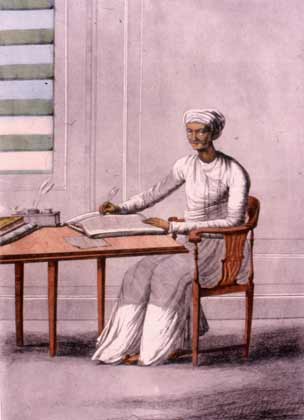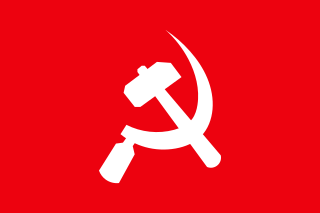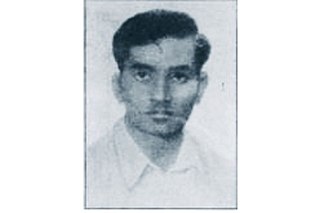Related Research Articles

A zamindar in the Indian subcontinent was an autonomous or semi-autonomous feudal ruler of a zamindari. The term itself came into use during the reign of Mughals, Marathas and later the British had begun using it as a native synonym for "estate". The term means landowner in Persian. They were typically hereditary, and held the right to collect tax on behalf of imperial courts or for military purposes.

Tebhaga movement (1946–1947) was significant peasant agitation, initiated in Bengal by the All India Kisan Sabha of peasant front of the Communist Party of India.
Namasudra, earlier known as Chandal, is an Avarna Bengali Hindu community originating from eastern and central Bengal. The term Chandal or Chandala is usually considered as a slur. They were traditionally engaged in fishing and as boatmen, and later in cultivation. They lived outside the four-tier ritual varna system and thus were outcastes.
Mahishya is a Bengali Hindu traditionally agrarian caste, and formed the largest caste in undivided Bengal. Mahisyas were, and still are, extremely diverse caste consisting of all possible classes in terms of material conditions and ranks.
Muslim communities in South Asia have a system of social stratification arising from concepts other than "pure" and "impure", which are integral to the caste system in India. It developed as a result of relations among foreign conquerors, local upper-caste Hindus forced to convert to Islam and local lower-caste converts (ajlaf), as well as the continuation of the Indian caste system by converts. Non-ashrafs are backward-caste converts. The concept of "pasmanda" includes ajlaf and arzal Muslims; ajlaf status is defined by descent from converts to Islam and by pesha (profession). These terms are not part of the sociological vocabulary in regions such as Kashmir and Uttar Pradesh, and say little about the functioning of Muslim society.
Bhumihar, also locally called Bhuinhar and Babhan, is a Hindu caste mainly found in Bihar, the Purvanchal region of Uttar Pradesh, Jharkhand, the Bundelkhand region of Madhya Pradesh, and Nepal.

The Naxalite–Maoist insurgency is an ongoing conflict between Maoist groups known as Naxalites or Naxals and the Indian government. The influence zone of the Naxalites is called the red corridor, which has been steadily declining in terms of geographical coverage and number of violent incidents, and in 2021 it was confined to the 25 "most affected" locations, accounting for 85% of Left Wing Extremism (LWE) violence, and 70 "total affected" districts across 10 states in two coal-rich, remote, forested hilly clusters in and around the Dandakaranya-Chhattisgarh-Odisha region and the tri-junction area of Jharkhand, Bihar, and West Bengal. The Naxalites have frequently targeted police and government workers in what they say is a fight for improved land rights and more jobs for neglected agricultural labourers and the poor.

Panchanan Barma (1866–1935), also known as Thakur Panchanan or Panchanan Sarkar, was a Rajbanshi leader and social reformer from Cooch Behar, West Bengal, India. He dedicated his life for the improvement of backward class people, specifically for his own backward Rajbanshi community. He established a KshatriyaSabhā to instill Brahminical values and practices in people of his own caste. He was popularly known as the father of the Rajbanshi society.
Jangal Santhal, also known as Jangal Santal was an Indian political activist.
Sadgop, also spelled as Sadgope, is a Bengali Hindu Yadav (Gopa) caste. Traditionally they are engaged in cultivation. Since late mediaeval period Sadgops had established themselves as dominant political power in peripheral lateritic forest areas of Rarh region, now included in Birbhum, Burdwan and Midnapore districts. Karnagarh, Narajole, Narayangarh and Balarampur in Midnapore and several other zamindari estates in Burdwan, Hooghly, Birbhum belonged to them. As of late nineteenth century they were one of the fourteen castes belonging to 'Nabasakh' group.

The Rajbanshi, also Rajbongshi and Koch-Rajbongshi, are peoples from Lower Assam, North Bengal, eastern Bihar, Terai region of eastern Nepal, Rangpur division of North Bangladesh and Bhutan who have in the past sought an association with the Koch dynasty. Koch-Rajbanshi people speak Kamatapuri, belong to Indo-Aryan languages, though in the past they might have spoken Tibeto-Burman languages. The community is categorised as OBC in Assam and Bihar, and SC in West Bengal. In Nepal they are considered part of the Plains Janjati. In Bangladesh the community is classified as Plains ethnic group under 'Barman'. They are the largest Scheduled Caste community of West Bengal.

Kulin Kayastha is a sub-caste of the Bengali Kayastha caste in Bengal region of Indian subcontinent. They are also known as the Kulina Kayasthas.
The Paswan, also known as Dusadh, are a Dalit community from eastern India. They are found mainly in the states of Bihar, Uttar Pradesh and Jharkhand. The Urdu word Paswan means bodyguard or "one who defends". The origin of the word, per the belief of the community, lies in their participation in the battle against Siraj-ud-daulah, the Nawab of Bengal at the behest of British East India Company, after which they were rewarded with the post of Chowkidars and lathi wielding tax collector for the Zamindars. They follow certain rituals such as walking on fire to assert their valour.
The Jat people are a traditionally agricultural community in Northern India and Pakistan. Originally pastoralists in the lower Indus river-valley of Sindh, many Jats migrated north into the Punjab region in late medieval times, and subsequently into the Delhi Territory, northeastern Rajputana, and the western Gangetic Plain in the 17th and 18th centuries. Of Hindu, Muslim and Sikh faiths, they are now found mostly in the Indian states of Punjab, Haryana, Uttar Pradesh and Rajasthan and the Pakistani provinces of Sindh and Punjab.

Naxalbari uprising was an armed peasant revolt in 1967 in the Naxalbari block of Siliguri subdivision in Darjeeling district, West Bengal, India. It was mainly led by tribals and the radical communist leaders of Bengal and further developed into the Communist Party of India (Marxist–Leninist) in 1969. The armed struggle became an inspiration to the Naxalite movement which rapidly spread from West Bengal to other states of India creating division within the Communist Party of India (Marxist) - India's primary communist party.

The Zamindars of Bihar were the autonomous and semi-autonomous rulers and administrators of the Mughal subah of Bihar and later during British rule. The zamindars of Bihar were numerous and could be divided into small, medium and large depending on how much land they controlled. Within Bihar, the zamindars had both economic and military power. Each zamindari would have their own standing army which was typically composed of their own clansmen.

Jagdish Mahto was an Indian communist activist. He was a naxal leader who led the 1970 Bhojpur uprising in the landlord-dominated Bhojpur region of Bihar. He was a member of the Communist Party of India (Marxist–Leninist), an organisation which was leading the Naxalite insurgency against the Government of India. He also fought against the upper-caste landlords for the cause of lower-caste people. Mahto, also called Master Saheb, was a member of the Bihar State Committee of CPI(M–L) and one of the founding leaders of the party in Bhojpur.
The Backward Caste movement in Bihar can be traced back to the formation of Triveni Sangh, a caste coalition and political party, in the 1930s, which was revived after the introduction of land reforms in the 1950s aimed at removing intermediaries from agrarian society. But, this drive could not succeed in bringing long-lasting changes in the condition of lower strata of society, as they lacked political representation and economic power. The period since land reform included caste conflicts and the class struggle which eventually led to a transfer of absolute political power in the hands of Backward Castes, who had been kept away from it earlier. The class struggle succeeded the struggle of some of the Upper Backward Castes against the sacerdotal authorities for improvement in their ritual status. By the 1990s, the conflict between upper-castes and the lower-castes continued, with nearly 17 massacres taking place during this time period. But with the advent of politics of social justice and the Janata Dal in the 1990s, the lower caste became more active politically.
Bhojpur uprising refers to the class conflict manifested in armed uprising of the 1970s, that took place in the various villages of the Bhojpur district of Bihar. These clashes were part of the Naxalite-Maoist insurgency in the state, which mobilised the agricultural labourers and the poor peasants against the landlords, primarily belonging to upper-castes. A distinguished feature of these insurgencies were their confinement to the villages, and the nine towns of the Bhojpur district remained unaffected from the periodic skirmishes between the armed groups. One of the reason sought for this peculiar feature is the absence of modern industries in the district. The economy of the district was primarily agrarian, and the industrial proletariat class was absent.

Dalits in Bihar are a social group composed of many Scheduled Castes, placed at the bottom of the "caste-based social order". The Dalits also include some of the erstwhile untouchable castes, who suffered various forms of oppression in the feudal-agrarian society of Bihar. Some of the Dalit castes have specific cultural practices, which differ from those of orthodox Hinduism.
References
- 1 2 Iqbal, I. (2010). The Bengal Delta: Ecology, State and Social Change, 1840-1943. Palgrave Macmillan UK. p. 107. ISBN 978-0-230-23183-2.
- ↑ Guha, Ayan (2022-09-26). The Curious Trajectory of Caste in West Bengal Politics: Chronicling Continuity and Change. BRILL. pp. 141–142. ISBN 978-90-04-51456-0.
- ↑ "The Naxalite Movement that was Not in Naxalbari". Mainstream. Retrieved 2016-04-30.
- ↑ "Naxalbari revisited". The Times of India. Retrieved 2016-04-30.